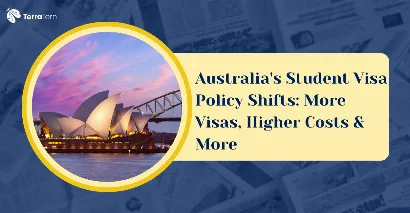Key Highlights
Australia's international education landscape is experiencing significant changes as the government announces a 9% increase in the Australia student visa cap for 2026, raising it from 270,000 to 295,000 places. Nevertheless, such growth is accompanied by rather significant increases in fees and more rigid processing requirements, which welcome mixed responses among students and education providers.
Also Read: Comprehensive Guide to the Australia Study Visa Process
Significant Changes to Australia's Student Visa Framework
Visa Cap Increase for 2026
The government of Australia has affirmed that international students in Australia will enjoy a larger quota in 2026. The new distribution falls into the following analysis:
-
Overall limit: 295,000 international learner places
-
Public universities: 145,000 places (increased allocation)
-
Higher education providers: 196,750 places in all
-
Sector Vocational education: Remaining allocation
This represents a strategic shift from the 2025 cap of 270,000, which was designed to bring "out of control" student numbers under management.
Student Visa Fee Increases
There has been a dramatic increase in the cost of the application for an Australian student visa:
|
Period |
Visa Fee |
Increase |
|
Pre-July 2024 |
AUD 710 |
- |
|
July 2024 |
AUD 1,600 |
125% |
|
Proposed July 2025 |
AUD 2,000 |
25% additional |
Such actions to increase student visa fees will raise AUD 760 million in four years for the government.
Also Read: Why Study in Australia? Latest Updated Guide
New Processing Categories
The government has implemented a system in which student visa applications would be processed in stages:
-
Priority 1 (High Priority): Applications from education providers below 80% of their allocated quota
-
Priority 2 (Standard Priority): Applications from providers at 80% or above capacity
Regional Focus Shifts to Southeast Asia
Australia's new education policy prioritises Southeast Asian applicants as part of the 'Invested: Australia's Southeast Asia Economic Strategy to 2040'. The strategic pivot seeks to:
-
Decrease the economic reliance on conventional source nations
-
Firm up relationships in the region
-
Increase the foreign student population. Mix up the foreign student group.
Although the number of source countries is still dominated by China and India, Indonesia, Vietnam, the Philippines, and Malaysia are shown to be actively welcoming by the government to make an application.
Impact on Different Student Categories
English Language Course Students
The sector most affected by recent changes has been English Language Intensive Courses for Overseas Students (ELICOS). Based on the statistics in the industry:
-
A 50 per cent drop in the number of new students signing up for English-related courses after the cost surge in July 2024
-
Applications have dropped to their lowest since 2005
-
There have been several instances of business and job losses as well
Higher Education Students
Universities are experiencing mixed impacts:
|
Sector |
2025 Impact |
Future Outlook |
|
Public Universities |
Maintaining base allocations |
Opportunity for additional places in 2026 |
|
Private Providers |
Facing capacity constraints |
Limited expansion opportunities |
|
Vocational Training |
Reduced priority |
Continued restrictions |
Also Read: Study In Australia- Unlocking A Complete Guide
Industry and Student Reactions
The industry and student reactions are:
Education Provider Concerns
Felix Pirie, CEO of the Independent Tertiary Education Council of Australia (ITECA), described the fee increases as "incredibly disappointing" and "purely revenue driven". The association argues that increasing the fees is strategically pointless and has inadequate sector knowledge.
Student Financial Pressure
International learners are complaining about rising expenses. Radhika, an MBA student in Melbourne, highlighted the challenge: "I can only work limited hours. I have rent to pay, a car to maintain, and two school-aged kids whose international education fees we're already covering".
Mixed Student Perspectives
There are considerable differences in the reactions of students:
-
Supportive view: Finance student Rahat Mirani believes higher fees might "discourage those who aren't serious about studying"
-
Critical view: Journalism student Jai Tiwari sees the increases as government efforts to "cut down the number of international students"
Regional Impact on Indian Students
Although Southeast Asia is the focus country, India remains a significant supply country. But here, students of India have more difficulties:
-
Stricter applications by six of the Indian states owing to issues of visa misuse
-
Increased review by the standards of the new Genuine Student requirements
-
Mandatory Confirmation of Enrolment (CoE) for all applications
Future Processing Changes
Some of the measures extended by the government towards improving the processing of student visas include:
Genuine Student Requirement
Replacing the previous Genuine Temporary Entrant (GTE) criteria, the new Genuine Student (GS) requirement focuses on:
-
Better evaluation of study purposes
-
Boosted monitoring of compliance
-
An emphasis on ideas anchored on a strong academic commitment
Documentation Requirements
Additional new compliance guidelines will be:
-
Confirmation of Enrolment (CoE) for all applications (replacing Letters of Offer)
-
Improved evidence of finances
-
Stiffer English language Sun: The James Mill of the English language, a great speaker of the English language, and a great reader.
Economic Implications
The modifications are also supposed to affect the economy in a larger sense:
-
Good: Stronger systems governance and more sustainable growth
-
Negative: Declining demand in student accommodation, shopping and hospitality industries
-
Revenue generation, by way of raising fees: an estimated AUD 760 million over four years
Also Read: Austria Study Visa - Charting A Course To Excellence
Looking Ahead: 2026 and Beyond
The Australia student visa cap increase for 2026 signals the government's commitment to international education while maintaining control measures. Some reasons for consideration are:
-
Institutions must demonstrate "good progress" toward 2025 allocations to receive additional places
-
Further focus on sincere student applications
-
Constant research to sustain the sectors
The government maintains that these reforms support Australia's position as a quality education destination while addressing infrastructure pressures and system integrity concerns.
Conclusion
Australia's student visa policy changes for 2026 represent a balancing act between growth and control. Although a higher visible Australia student visa cap presents more options to legitimate students, higher fees and tighter standards are set to change the face. International students will have to take on these changes with caution and can look forward to the opportunities in addition to the challenges that loom. The success of these policies will depend on their ability to maintain Australia's attractiveness as an education destination while ensuring system sustainability and integrity. Contact TerraTern for more information!








